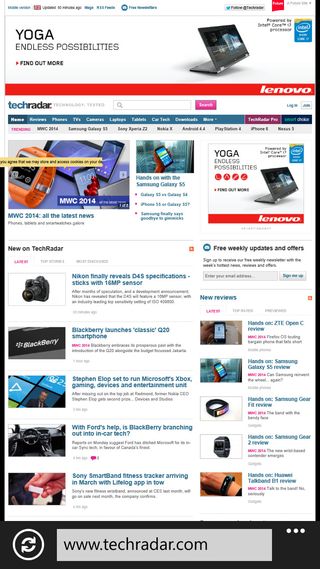Why you can trust TechRadar
Battery life
One component the Nokia Lumia 1320 shares with its premium-grade brother, the Lumia 1520, is its 3,400mAh battery.
The result of this, when allied to the 1320's power-sipping processor and less power-hungry display, is phenomenal battery life.
I found I could clear two days of moderate use in a single charge, incorporating emails, multiple games, some light web browsing, a few phone calls, dozens of photos, and some general exploration of the Windows Phone 8 OS.

All with the screen brightness pumped up to maximum, too.
More scientifically, the standard TechRadar battery test of running a 90 minute 720p video – filled with constant, looping sound and motion – with the screen set to maximum brightness and all notifications en-abled, yielded some of the best results I've ever seen.
And that's without activating Battery Saver mode, too.
An average result of 92% battery life remaining speaks to the Nokia Lumia 1320's supreme stamina, and suggests that this is a device you should consider for those media-filled long trips.
I should also note that the same test yielded a result of 84% on the Nokia Lumia 1520, and that was pretty strong.
As already mentioned, this difference can be attributed to the 1320's processor having half the cores and a lower clock speed, which is in turn used to push half the number of pixels on its 6-inch display.
Battery life is just about the only area in which the Nokia Lumia 1320 out-performs the 1520, but it's a notable one.
The essentials
The Nokia Lumia 1320 runs on Windows Phone 8, which doesn't tend to vary much between handsets, so pretty much all of the phone's software features have been seen before.

That means that you get some typically strong Nokia apps, including HERE Maps, which is just about the only mapping application capable of giving Google Maps something to think about.
This is chiefly because it features an excellent offline map facility that allows you to pre-install a whole country's worth of data for quick, reliable access.
In a similar fashion, HERE Drive is a superb navigation app. Its reliable performance and intuitive interface mean that you can genuinely consider putting your dedicated sat nav system on eBay should you pick up the 1320. Needless to say, it works especially well on a 6-inch display.
As with every other Windows Phone-powered device, the Nokia Lumia 1320's default web browser is Internet Explorer. Microsoft's mobile OS has been sidelined with the explosion of Chrome and Safari on other, more popular platforms, but it's actually not bad.
I like how Microsoft continues to place the universal address bar at the bottom of the screen, making it that little bit more accessible in a snip. It's also pretty swift at loading up websites.

The mobile version of TechRadar's homepage loaded up virtually instantaneously, while the content-packed desktop version took about 12 seconds to finish loading in every last element.
It was fully usable within three seconds – all of which is comparable with other modern devices, including the 1520.
Of course, one of the advantages of a 6-inch display is that you can enjoy some kind of full web experience, albeit with a little panning and zooming.
However, this is where the benefits of the 1520's 1080p resolution is most keenly felt, as very small text is rendered just that little bit fuzzy and indistinct on the 1320's 720p equivalent.
I'll discuss the Nokia Lumia 1320's camera next, but it's good (if predictable) to see the Nokia Creative Studio app bundled here. As well as letting you apply simple filters to your snaps, it also lets you apply advanced effects that you don't often get with such default apps.

For example, you can give the photo a monochrome palette before cranking up the full colour on individual elements, or bring background objects into greater focus by blurring out the foreground. You can also do more regular things like crop and adjust the colour balance here.
The one area of a modern mobile phone that often gets ignored or taken for granted is call quality. It's fine here, if a little quieter than expected. I found myself cranking up the call volume to better hear the voice on the other end, but general quality is perfectly okay.

